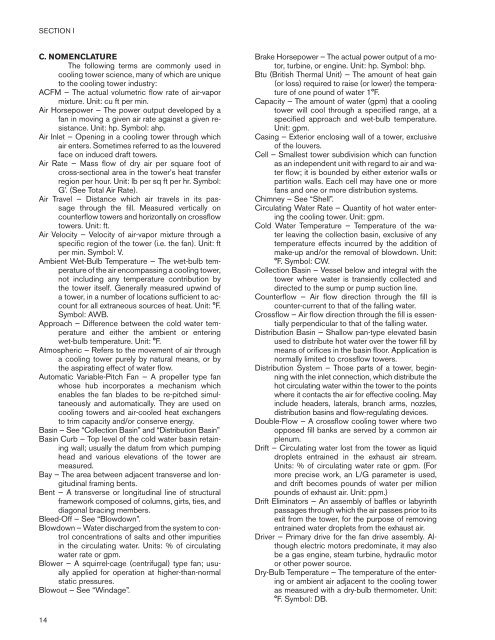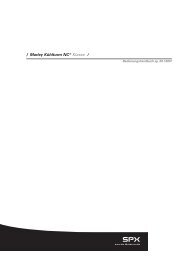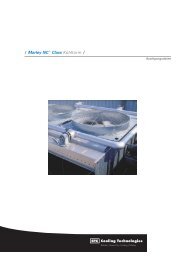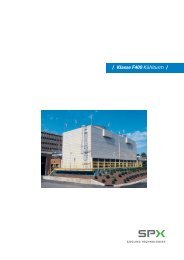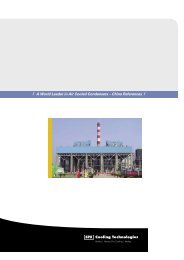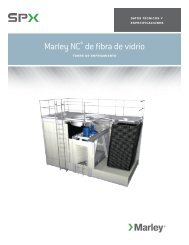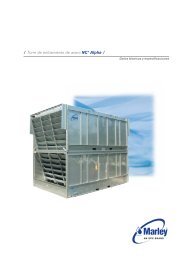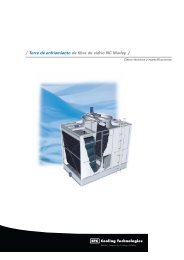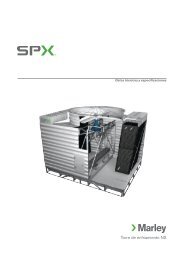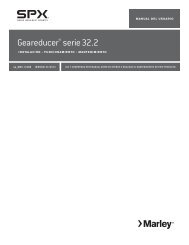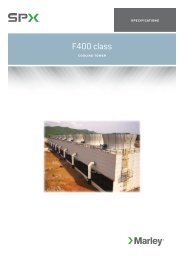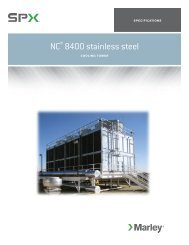Cooling Tower Fundamentals - SPX Cooling Technologies
Cooling Tower Fundamentals - SPX Cooling Technologies
Cooling Tower Fundamentals - SPX Cooling Technologies
You also want an ePaper? Increase the reach of your titles
YUMPU automatically turns print PDFs into web optimized ePapers that Google loves.
SECTION I<br />
C. NOMENCLATURE<br />
The following terms are commonly used in<br />
cooling tower science, many of which are unique<br />
to the cooling tower industry:<br />
ACFM — The actual volumetric flow rate of air-vapor<br />
mixture. Unit: cu ft per min.<br />
Air Horsepower — The power output developed by a<br />
fan in moving a given air rate against a given resistance.<br />
Unit: hp. Symbol: ahp.<br />
Air Inlet — Opening in a cooling tower through which<br />
air enters. Sometimes referred to as the louvered<br />
face on induced draft towers.<br />
Air Rate — Mass flow of dry air per square foot of<br />
cross-sectional area in the tower’s heat transfer<br />
region per hour. Unit: lb per sq ft per hr. Symbol:<br />
G’. (See Total Air Rate).<br />
Air Travel — Distance which air travels in its passage<br />
through the fill. Measured vertically on<br />
counterflow towers and horizontally on crossflow<br />
towers. Unit: ft.<br />
Air Velocity — Velocity of air-vapor mixture through a<br />
specific region of the tower (i.e. the fan). Unit: ft<br />
per min. Symbol: V.<br />
Ambient Wet-Bulb Temperature — The wet-bulb temperature<br />
of the air encompassing a cooling tower,<br />
not including any temperature contribution by<br />
the tower itself. Generally measured upwind of<br />
a tower, in a number of locations sufficient to account<br />
for all extraneous sources of heat. Unit: °F.<br />
Symbol: AWB.<br />
Approach — Difference between the cold water temperature<br />
and either the ambient or entering<br />
wet-bulb temperature. Unit: °F.<br />
Atmospheric — Refers to the movement of air through<br />
a cooling tower purely by natural means, or by<br />
the aspirating effect of water flow.<br />
Automatic Variable-Pitch Fan — A propeller type fan<br />
whose hub incorporates a mechanism which<br />
enables the fan blades to be re-pitched simultaneously<br />
and automatically. They are used on<br />
cooling towers and air-cooled heat exchangers<br />
to trim capacity and/or conserve energy.<br />
Basin — See “Collection Basin” and “Distribution Basin”<br />
Basin Curb — Top level of the cold water basin retaining<br />
wall; usually the datum from which pumping<br />
head and various elevations of the tower are<br />
measured.<br />
Bay — The area between adjacent transverse and longitudinal<br />
framing bents.<br />
Bent — A transverse or longitudinal line of structural<br />
framework composed of columns, girts, ties, and<br />
diagonal bracing members.<br />
Bleed-Off — See “Blowdown”.<br />
Blowdown — Water discharged from the system to control<br />
concentrations of salts and other impurities<br />
in the circulating water. Units: % of circulating<br />
water rate or gpm.<br />
Blower — A squirrel-cage (centrifugal) type fan; usually<br />
applied for operation at higher-than-normal<br />
static pressures.<br />
Blowout — See “Windage”.<br />
14<br />
Brake Horsepower — The actual power output of a motor,<br />
turbine, or engine. Unit: hp. Symbol: bhp.<br />
Btu (British Thermal Unit) — The amount of heat gain<br />
(or loss) required to raise (or lower) the temperature<br />
of one pound of water 1°F.<br />
Capacity — The amount of water (gpm) that a cooling<br />
tower will cool through a specified range, at a<br />
specified approach and wet-bulb temperature.<br />
Unit: gpm.<br />
Casing — Exterior enclosing wall of a tower, exclusive<br />
of the louvers.<br />
Cell — Smallest tower subdivision which can function<br />
as an independent unit with regard to air and water<br />
flow; it is bounded by either exterior walls or<br />
partition walls. Each cell may have one or more<br />
fans and one or more distribution systems.<br />
Chimney — See “Shell”.<br />
Circulating Water Rate — Quantity of hot water entering<br />
the cooling tower. Unit: gpm.<br />
Cold Water Temperature — Temperature of the water<br />
leaving the collection basin, exclusive of any<br />
temperature effects incurred by the addition of<br />
make-up and/or the removal of blowdown. Unit:<br />
°F. Symbol: CW.<br />
Collection Basin — Vessel below and integral with the<br />
tower where water is transiently collected and<br />
directed to the sump or pump suction line.<br />
Counterflow — Air flow direction through the fill is<br />
counter-current to that of the falling water.<br />
Crossflow — Air flow direction through the fill is essentially<br />
perpendicular to that of the falling water.<br />
Distribution Basin — Shallow pan-type elevated basin<br />
used to distribute hot water over the tower fill by<br />
means of orifices in the basin floor. Application is<br />
normally limited to crossflow towers.<br />
Distribution System – Those parts of a tower, beginning<br />
with the inlet connection, which distribute the<br />
hot circulating water within the tower to the points<br />
where it contacts the air for effective cooling. May<br />
include headers, laterals, branch arms, nozzles,<br />
distribution basins and flow-regulating devices.<br />
Double-Flow — A crossflow cooling tower where two<br />
opposed fill banks are served by a common air<br />
plenum.<br />
Drift — Circulating water lost from the tower as liquid<br />
droplets entrained in the exhaust air stream.<br />
Units: % of circulating water rate or gpm. (For<br />
more precise work, an L/G parameter is used,<br />
and drift becomes pounds of water per million<br />
pounds of exhaust air. Unit: ppm.)<br />
Drift Eliminators — An assembly of baffles or labyrinth<br />
passages through which the air passes prior to its<br />
exit from the tower, for the purpose of removing<br />
entrained water droplets from the exhaust air.<br />
Driver — Primary drive for the fan drive assembly. Although<br />
electric motors predominate, it may also<br />
be a gas engine, steam turbine, hydraulic motor<br />
or other power source.<br />
Dry-Bulb Temperature — The temperature of the entering<br />
or ambient air adjacent to the cooling tower<br />
as measured with a dry-bulb thermometer. Unit:<br />
°F. Symbol: DB.


